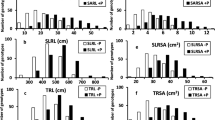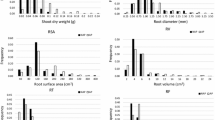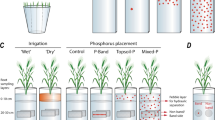Abstract
Identification of “donors” possessing superior traits to adapt to low phosphorus (P) soils is a primary requirement to develop efficient crop plants for sustainable agricultural production. Diverse wheat (Triticum aestivum L., 89) and triticale (×Triticosecale Wittmack, 15) genotypes were phenotyped in soil with low and sufficient P for two seasons and once in the hydroponic system. Principal component analysis of relative biomass and grain weight revealed four clusters each for wheat and triticale. In low P soil, genotypes in the efficient cluster showed lesser reduction in total biomass, grain weight, total P uptake, and harvest index (HI), and improved P acquisition efficiency (PAE) and P harvest index (PHI) as compared to the inefficient cluster. In hydroponics, reduction in total biomass was less while root biomass and PAE increased at low P in the efficient genotypes. Out of 22 (soil) and 38 (hydroponics) P-efficient wheat genotypes, nine were overlapping in both screens while in P-inefficient cluster, out of 23 (soil) and 5 (hydroponics), three were common. A few P-efficient genotypes identified were DL784-3, DBW 16, and GW 322 and triticale TREAT, whereas P inefficient were C306 and ABACUS PVR (triticale). The selections in hydroponics are likely to be relevant in the field as demonstrated by overlapping of genotypes in both the mediums. Genotypic variations in P efficiency were strongly associated with P utilization rather than P uptake.







Similar content being viewed by others
Abbreviations
- P:
-
Phosphorus
- PAE:
-
Phosphorus acquisition efficiency
- HI:
-
Harvest index
- PHI:
-
Phosphorus harvest index
- PCA:
-
Principal component analysis
References
Ahmad Z, Ahmad Z, Gill MA, Qureshi RH, Hamud-Ur-Rehman MT (2001) Phosphorus nutrition of cotton cultivars under deficient and adequate levels in solution culture. Commun Soil Sci Plant Anal 32:171–187. https://doi.org/10.1081/CSS-100103001
Akhtar MS, Oki Y, Adachi T (2008) Genetic diversity of Brassica cultivars in relation to phosphorus uptake and utilization efficiency under P-stress environment. Arch Agron Soil Sci 54:93–108. https://doi.org/10.1080/03650340701663574
Aulakh MS, Pasricha NS, Bahl GS (2003) Phosphorus fertilizer response in an irrigated soybean-wheat production system on a subtropical, semiarid soil. Field Crops Res 80:99–109. https://doi.org/10.1016/S0378-4290(02)00172-7
Batten GD (1986) Phosphorus fractions in the grain of diploid, tetraploid, and hexaploid wheat grown with contrasting phosphorus supplies. Cereal Chem 63:384–387
Bhargava BS, Raghupathi HB (1998) Analysis of plant materials for macro and micronutrients. In: Tandon HLS (ed) Methods of analysis of soils, plants. Waters and Fertilisers. Fertilizer Development and Consultation Organisation, New Delhi, pp 58–59
Bilal HM, Aziz T, Maqsood MA, Farooq M, Yan G (2018) Categorization of wheat genotypes for phosphorus efficiency. PLoS One 13:e0205471. https://doi.org/10.1371/journal.pone.0205471
Cakmak I, Ekiz H, Yilmaz A, Torun B, Koleli N, Gultekin I, Alkan A, Eker S (1997) Different response of rye, triticale, bread and durum wheats to zinc efficiency in calcareous soils. Plant Soil 188:1–10. https://doi.org/10.1023/A:1004247911381
Ciereszko I, Gniazdowska A, Mikulska M, Rychter AM (1996) Assimilate translocation in bean plants (Phaseolus vulgaris L.) during phosphate deficiency. J Plant Physiol 149:343–348. https://doi.org/10.1016/S0176-1617(96)80132-5
Conyers MK, Moody PW (2009) A conceptual framework for improving the P efficiency of organic farming without inputs of soluble P fertiliser. Crop Pasture Sci 60:100–104. https://doi.org/10.1071/CP06327
Cordell D, Drangert JO, White S (2009) The story of phosphorus: global food security and food for thought. Global Environ Chang 19:292–305. https://doi.org/10.1016/2008.10.009
de Sousa SM, Clark RT, Mendes FF, de Oliveira AC, de Vasconcelos MJV, Parentoni SN, Kochian LV, Guimaraes CT, Magalhaes JV (2012) A role for root morphology and related candidate genes in P acquisition efficiency in maize. Funct Plant Biol 39:925–935. https://doi.org/10.1071/FP12022
Elanchezhian R, Krishnapriya V, Pandey R, Rao AS, Abrol YP (2015) Physiological and molecular approaches for improving phosphorus uptake efficiency of crops. Curr Sci 108:1271–1279
Fageria NK, Baligar VC (1997a) Phosphorus-use efficiency by corn genotypes. J Plant Nutr 20:1267–1277. https://doi.org/10.1080/01904169709365334
Fageria NK, Baligar VC (1997b) Upland rice genotypes evaluation for phosphorus use efficiency. J Plant Nutr 20:499–509. https://doi.org/10.1080/01904169709365270
Fageria NK, Baligar VC (1999) Phosphorus-use efficiency in wheat genotypes. J Plant Nutr 22:331–340. https://doi.org/10.1080/01904169909365630
Fageria NK, da Costa JGC (2000) Evaluation of common bean genotypes for phosphorus use efficiency. J Plant Nutr 23:1145–1152. https://doi.org/10.1080/01904160009382088
Fageria NK, Wright RJ, Baligar VC (1988) Rice cultivar evaluation for phosphorus use efficiency. Plant Soil 111:105–109. https://doi.org/10.1007/BF02182043
Fageria NK, Baligar VC, Moreira A, Portes TA (2010) Dry bean genotypes evaluation for growth, yield components and phosphorus use efficiency. J Plant Nutr 33:2167–2181. https://doi.org/10.1080/01904167.2010.519089
Furlani AMC, Furlani PR, Tanaka RT, Mascarenhas HAA, Delgado MDP (2002) Variability of soybean germplasm in relation to phosphorus uptake and use efficiency. Sci Agric 59:529–536. https://doi.org/10.1590/S0103-90162002000300018
Gahoonia TS, Nielsen NE (2004) Root traits as tools for creating phosphorus efficient crop varieties. Plant Soil 260:47–57. https://doi.org/10.1023/B:PLSO.0000030168.53340.bc
Gill HS, Singh A, Sethi SK, Behl RK (2004) Phosphorus uptake and use efficiency in different varieties of bread wheat (Triticum aestivum). Arch Agron Soil Sci 50:563–572. https://doi.org/10.1080/03650340410001729708
Godfray HCJ, Beddington JR, Crute IR, Haddad L, Lawrence D, Muir JF, Pretty J, Robinson S, Thomas SM, Toulmin C (2010) Food security: the challenge of feeding 9 billion people. Science 327:812–818. https://doi.org/10.1126/science.1185383
Graham RD (1984) Breeding for nutritional characteristics in cereals. In: Tinker PB, Lauchli A (eds) Advances in plant nutrition. Preagier Publishers, New York, pp 57–102
Gunes A, Inal A, Alpaslan M, Cakmak I (2006) Genotypic variation in phosphorus efficiency between wheat cultivars grown under greenhouse and field conditions. Soil Sci Plant Nutr 52:470–478. https://doi.org/10.1111/j.1747-0765.2006.00068.x
Hammond JP, Broadley MR, White PJ, King GJ, Bowen HC, Hayden R, Meacham MC, Mead A, Overs T, Spracklen WP, Greenwood DJ (2009) Shoot yield drives phosphorus use efficiency in Brassica oleracea and correlates with root architecture traits. J Exp Bot 60:1953–1968. https://doi.org/10.1093/jxb/erp083
Hansen CW, Lynch JP, Ottosen CO (1998) Response to phosphorus availability during vegetative and reproductive growth in chrysanthemum: whole plant carbon dioxide exchange. J Am Soc Horti Sci 123:215–222. https://doi.org/10.21273/JASHS.123.2.215
Hayes JE, Zhu YG, Mimura T, Reid RJ (2004) An assessment of the usefulness of solution culture in screening for phosphorus efficiency in wheat. Plant Soil 261:91–97. https://doi.org/10.1023/B:PLSO.0000035561.00460.8b
Heffer P (2013) Assessment of fertilizer use by crop at the global level. International Fertilizer Industry Association, Paris
Horst WJ, Abdou M, Wiesler F (1993) Genotypic differences in phosphorus efficiency of wheat. Plant Soil 155:293–296. https://doi.org/10.1007/BF00025040
Hu Y, Ye Z, Shi L, Duan H, Xu F (2010) Genotypic differences in root morphology and phosphorus uptake kinetics in Brassica napus under low phosphorus supply. J Plant Nutr 33:889–901. https://doi.org/10.1080/01904161003658239
Jones GPD, Blair GJ, Jessop RS (1989) Phosphorus efficiency in wheat—a useful selection criterion? Field Crops Res 21:257–264. https://doi.org/10.1016/0378-4290(89)90007-5
Jones GPD, Jessop RS, Blair GJ (1992) Alternative methods for the selection of phosphorus efficiency in wheat. Field Crops Res 30:29–40. https://doi.org/10.1016/0378-4290(92)90054-D
Korkmaz K, Ibrikci H, Karnez E, Buyuk G, Ryan J, Ulger AC, Oguz H (2009) Phosphorus use efficiency of wheat genotypes grown in calcareous soils. J Plant Nutri 32:2094–2106. https://doi.org/10.1080/01904160903308176
Krishnapriya V, Pandey R (2016) Root exudation index: screening organic acid exudation and phosphorus acquisition efficiency in soybean genotypes. Crop Pasture Sci 67:1096–1109. https://doi.org/10.1071/CP15329
Lambers H, Shane MW, Cramer MD, Pearse SJ, Veneklaas EJ (2006) Root structure and functioning for efficient acquisition of phosphorus: matching morphological and physiological traits. Ann Bot 98:693–713. https://doi.org/10.1093/aob/mcl114
Lambers H, Clements JC, Nelson MN (2013) How a phosphorus-acquisition strategy based on carboxylate exudation powers the success and agronomic potential of lupines (Lupinus, Fabaceae). Am J Bot 100:263–288. https://doi.org/10.3732/ajb.1200474
Liao H, Yan X (1999) Seed size is closely correlated to phosphorus use efficiency and photosynthetic phosphorus use efficiency in common bean. J Plant Nutr 22:877–888. https://doi.org/10.1080/01904169909365679
Liao M, Hocking PJ, Dong B, Delhaize E, Richardson AE, Ryan PR (2008) Variation in early phosphorus-uptake efficiency among wheat genotypes grown on two contrasting Australian soils. Aust J Agri Res 59:157–166. https://doi.org/10.1071/AR06311
Lopez-Arrendondo DL, Levya-Gonzalez MA, Gonzalez-Morales SI, Lopez-Bucio J, Herrera-Estrella L (2014) Phosphate nutrition: improving low-phosphate tolerance in crops. Annu Rev Plant Biol 65:95–123. https://doi.org/10.1146/annurev-arplant-050213-035949
Manske GGB, Ortiz-Monasterio JI, Van Ginkel M, Gonzalez RM, Rajaram S, Molina E, Vlek PLG (2000) Traits associated with improved P-uptake efficiency in CIMMYT's semidwarf spring bread wheat grown on an acid Andisol in Mexico. Plant Soil 221:189–204. https://doi.org/10.1023/A:1004727201568
Manske GGB, Ortiz-Monasterio JI, VanGinkel M, Gonzalez RM, Fischer RA, Rajaram S, Vlek PLG (2001) Importance of P uptake efficiency versus P utilization for wheat yield in acid and calcareous soils in Mexico. Eur J Agron 14:261–274. https://doi.org/10.1016/S1161-0301(00)00099-X
McDonald G, Bovill W, Taylor J, Wheeler R (2015) Responses to phosphorus among wheat genotypes. Crop Pasture Sci 66:430–444. https://doi.org/10.1071/CP14191
McNear DH Jr (2013) The rhizosphere-roots, soil and everything in between. Nat Edu Knowledge 4:1
Meena SK, Pandey R, Sharma S, Gayacharan KT, Singh MP, Dikshit HK (2021) Physiological basis of combined stress tolerance to low phosphorus and drought in a diverse set of mungbean germplasm. Agronomy 11:99. https://doi.org/10.3390/agronomy11010099
Mergoum M, Gómez-Macpherson H (2004) Triticale improvement and production. Food & Agriculture Org, Rome, p 179
Murphy J, Riley JP (1962) A modified single solution method for the determination of phosphate in natural waters. Anal Chim Acta 27:31–36. https://doi.org/10.1016/S0003-2670(00)88444-5
Olsen SR, Cole CV, Watanabe FS, Dean LA (1954) Estimation of available phosphorus in soils by extraction with sodium bicarbonate. USDA Circular, p 939
Osborne LD, Rengel Z (2002) Screening cereals for genotypic variation in efficiency of phosphorus uptake and utilization. Crop Pasture Sci 53:295–303. https://doi.org/10.1071/AR01080
Ozturk L, Eker S, Torun B, Cakmak I (2005) Variation in phosphorus efficiency among 73 bread and durum wheat genotypes grown in a phosphorus-deficient calcareous soil. Plant Soil 69:69–80. https://doi.org/10.1007/s11104-004-0469-z
Pandey R, Singh B, Nair TVR (2005) Phosphorus use efficiency of wheat, rye and triticale under deficient and sufficient levels of P. Indian J Plant Physiol 10:292–296
Pandey R, Meena SK, Krishnapriya V, Ahmad A, Kishora N (2014) Root carboxylate exudation capacity under phosphorus stress does not improve grain yield in green gram. Plant Cell Rep 33:919–928. https://doi.org/10.1007/s00299-014-1570-2
Pandey R, Lal MK, Vengavasi K (2018) Differential response of hexaploid and tetraploid wheat to interactive effects of elevated [CO2] and low phosphorus. Plant Cell Rep 37:1231–1244. https://doi.org/10.1007/s00299-018-2307-4
Panigrahy M, Rao DN, Yugandhar P, Raju NS, Krishnamurthy P, Voleti SR, Singh K (2014) Hydroponic experiment for identification of tolerance traits developed by rice Nagina 22 mutants to low-phosphorus in field condition. Arch Agron Soil Sci 60:565–576. https://doi.org/10.1080/03650340.2013.821197
R Development Core Team (2005). R: a language and environment for statistical computing. R Foundation for Statistical Computing, Vienna, Austria. ISBN 3–900051–07-0, URL: http://www.R-project.org
Raghothama KG, Karthikeyan AS (2005) Phosphate acquisition. Plant Soil 274:37–49. https://doi.org/10.1007/s11104-004-2005-6
Rengel Z (1999) Physiological mechanisms underlying differential nutrient efficiency of crop genotypes. In: Rengel Z (ed) Mineral nutrition of crops: fundamental mechanisms and implications. Food Products Press, New York, pp 227–265
Rose TJ, Rose MT, Tanaka JP, Heuer S, Wissuwa M (2011) The frustration with utilization: why have improvements in internal phosphorus utilization efficiency in crops remained so elusive? Front Plant Sci 2:73. https://doi.org/10.3389/fpls.2011.00073
Rose TJ, Mori A, Julia CC, Wissuwa M (2015) Screening for internal phosphorus utilisation efficiency: comparison of genotypes at equal shoot P content is critical. Plant Soil 401:79–91. https://doi.org/10.1007/s11104-015-2565-7
Sandana P, Pinochet D (2011) Ecophysiological determinants of biomass and grain yield of wheat under P deficiency. Field Crops Res 120:311–319. https://doi.org/10.1016/j.fcr.2010.11.005
Singh AL, Basu MS (2005) Integrated nutrient management in groundnut- a farmers manual. National Research Center for Groundnut (ICAR). Junagadh, Indian, p 54
Slaski JJ (1994) Differences in the metabolic responses of root tips of wheat and rye to aluminium stress. Plant Soil 167:165–171. https://doi.org/10.1007/BF01587612
Vance CP, Uhde-Stone C, Allan DL (2003) Phosphorus acquisition and use: critical adaptations by plants for securing a non-renewable resource. New Phytol 157:423–447. https://doi.org/10.1046/j.1469-8137.2003.00695.x
Vesterager J, HØgh-Jensen H, Nielsen NE (2006) Variation in phosphorus uptake and use efficiencies between pigeon pea genotypes and cowpea. J Plant Nutr 29:1869–1888. https://doi.org/10.1080/01904160600899436
Wang Y, Lambers H (2019) Root-released organic anions in response to low phosphorus availability: recent progress, challenges and future perspectives. Plant Soil 447:135–156. https://doi.org/10.1007/s11104-019-03972-8
Wang X, Tang C, Guppy CN, Sale PWG (2008) Phosphorus acquisition characteristics of cotton (Gossypium hirsutum L.), wheat (Triticum aestivum L.) and white lupin (Lupinus albus L.) under P deficient conditions. Plant Soil 312:117–128. https://doi.org/10.1007/s11104-008-9589-1
Wang X, Shen J, Liao H (2010) Acquisition or utilization, which is more critical for enhancing phosphorus efficiency in modern crops? Plant Sci 179:302–306. https://doi.org/10.1016/j.plantsci.2010.06.007
Wissuwa M, Gamat G, Islamail AM (2005) Is root growth under phosphorus deficiency affected by source or sink limitation? J Exp Bot 56:1943–1950. https://doi.org/10.1093/jxb/eri189
Wissuwa M, Mazzola M, Picard C (2009) Novel approaches in plant breeding for rhizosphere-related traits. Plant Soil 321:409–430. https://doi.org/10.1007/s11104-008-9693-2
Zhou T, Du Y, Ahmed S, Liu T, Ren M, Liu W, Yang W (2016) Genotypic differences in phosphorus efficiency and the performance of physiological characteristics in response to low phosphorus stress of soybean in southwest of China. Front Plant Sci 7:1776. https://doi.org/10.3389/fpls.2016.01776
Zhu J, Zhang C, Lynch JP (2010) The utility of phenotypic plasticity of root hair length for phosphorus acquisition. Funct Plant Bio 37:313–322. https://doi.org/10.1071/FP09197
Acknowledgements
We acknowledge the Indian Institute of Wheat & Barley Research, Karnal (India), Punjab Agricultural University, Ludhiana (India), Australian Winter Cereals Collection (Australia), and CIMMYT (Mexico) for providing the seed material.
Funding
This study was funded by the Council of Scientific and Industrial Research, New Delhi, India (Grant # 38(1494)/19/EMR-II).
Author information
Authors and Affiliations
Contributions
Conceptualization—RP; funding acquisition—RP; investigation—PRS, DS; methodology—PRS, DS, SS; project administration—RP; resources—RP, AMS; supervision—RP, AMS; validation—SPR; roles/writing–original draft—PRS; writing–review and editing—RP, SS, AMS, DS.
Corresponding author
Ethics declarations
Ethical Approval
Not applicable.
Conflict of Interest
The authors declare no competing interests.
Additional information
Publisher’s note
Springer Nature remains neutral with regard to jurisdictional claims in published maps and institutional affiliations.
Supplementary Information
ESM 1
(DOCX 1180 kb)
Rights and permissions
About this article
Cite this article
Soumya, P.R., Singh, D., Sharma, S. et al. Evaluation of Diverse Wheat (Triticum aestivum) and Triticale (× Triticosecale) Genotypes for Low Phosphorus Stress Tolerance in Soil and Hydroponic Conditions. J Soil Sci Plant Nutr 21, 1236–1251 (2021). https://doi.org/10.1007/s42729-021-00436-w
Received:
Accepted:
Published:
Issue Date:
DOI: https://doi.org/10.1007/s42729-021-00436-w




